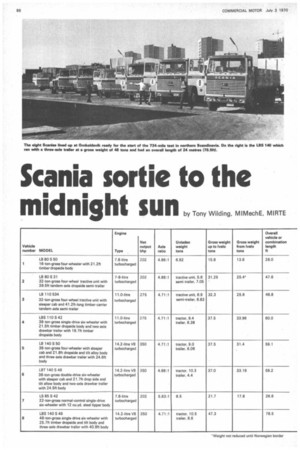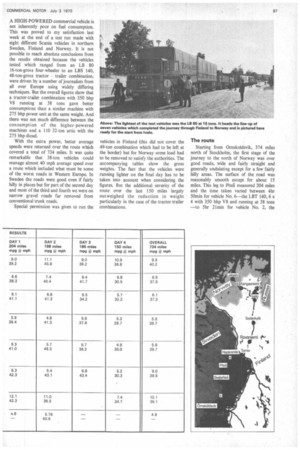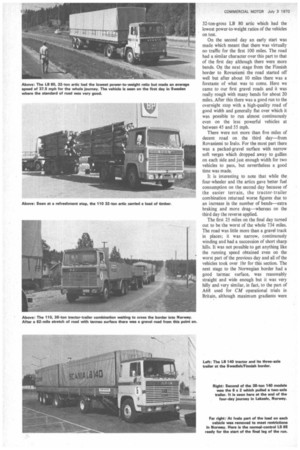Scania sortie to the midnight sun
Page 88

Page 89

Page 90

Page 91

If you've noticed an error in this article please click here to report it so we can fix it.
by Tony Wilding, MIMechE, MIRTE A HIGH-POWERED commercial vehicle is not inherently poor on fuel consumption. This was proved to my satisfaction last week at the end of a test run made with eight different Scania vehicles in northern Sweden, Finland and Norway. It is not possible to reach absolute conclusions from the results obtained because the vehicles tested which ranged from an LB 80 16-ton-gross four-wheeler to an LBS 140, 48-ton-gross tractor trailer combination, were driven by a number of journalists from all over Europe using widely differing techniques. But the overall figures show that a tractor-trailer combination with 350 bhp V8 running at 38 tons gave better consumptions than a similar machine with 275 bhp power unit at the same weight. And there was not much difference between the consumption of the higher-powered machines and a 110 32-ton artic with the 275 bhp diesel.
With the extra power, better average speeds were returned over the route which covered a total of 734 miles. It was quite remarkable that 38-ton vehicles could manage almost 40 mph average speed over a route which included what must be some of the worst roads in Western Europe. In Sweden the roads were good even if fairly hilly in places but for part of the second day and most of the third and fourth we were on narrow gravel roads far removed from conventional trunk roads.
Special permission was given to run the vehicles in Finland (this did not cover the 49-ton combination which had to be left at the border) but for Norway some load had to be removed to satisfy the authorities. The accompanying tables show the gross weights. The fact that the vehicles were running lighter on the final day has to be taken into account when considering the figures. But the additional severity of the route over the last 150 miles largely outweighed the reduction in weight particularly in the case of the tractor-trailer combinations.
The route
Starting from Ornskoldsvik, 374 miles north of Stockholm, the first stage of the journey to the north of Norway was over good roads, wide and fairly straight and generally undulating except for a few fairly hilly areas. The surface of the road was reasonably smooth except for about 15 miles. This leg to Pitea measured 204 miles and the time taken varied between 4hr 50min for vehicle No. 6-the LBT 140, 6 x 4 with 350 bhp V8 and running at 38 tons -to 5hr 21min for vehicle No. 2, the 32-ton-gross LB 80 artic which had the lowest power-to-weight ratios of the vehicles on test.
On the second day an early start was made which meant that there was virtually no traffic for the first 100 miles. The road had a similar character over this part to that of the first day although there were more bends. On the next stage from the Finnish border to Rovaniemi the road started off well but after about 10 miles there was a foretaste of what was to come. Here we came to our first gravel roads and it was really rough with many bends for about 20 miles. After this there was a good run to the overnight stop with a high-quality road of good width and generally flat over which it was possible to run almost continuously even on the less powerful vehicles at between 45 and 55 mph.
There were not more than five miles of decent road on the third day—from Rovanierni to Iralo. For the most part there was a packed-gravel surface with narrow soft verges which dropped away to gullies on each side and just enough width for two vehicles to pass, but nevertheless a good time was made.
It is interesting to note that while the four-wheeler and the artics gave better fuel consumption on the second day because of the easier terrain, the tractor-trailer combination returned worse figures due to an increase in the number of bends—extra braking and more drag—whereas on the third day the reverse applied.
The first 25 miles on the final day turned out to be the worst of the whole 734 miles. The road was link more than a gravel track in places; it was narrow, continuously winding and had a succession of short sharp hills. It was not possible to get anything like the running speed obtained even on the worst part of the previous day and all of the vehicles took over 1hr for this section. The next stage to the Norwegian border had a good tarmac surface, was reasonably straight and wide enough but it was very hilly and very similar, in fact, to the part of A68 used for CM operational trials in Britain, although maximum gradients were
about 1 in 10. After the border at Karigasniemi the road was once again bad and for the rest of the journey it was just a little better than during the first part of the final day.
Looking at the pattern of this Scania test, the daily distances were progressively shorter but after the second day the difficulty of the terrain worsened progressively. As a result, daily-journey times were fairly constant for the last three days with the fastest vehicle taking just over four hours for each leg and the slowest about one hour longer.
The vehicles tested The eight models put through the test represented the full range produced by Scania. Lightest was the LB 80 16-ton-gross four-wheeler followed by the LS 85 normal-control 22-ton-gross 6 x 2 tipper. There were two tractive units running at 32 tons gross—the LB 80 with 202 bhp engine and LB 110 with 275 bhp—and three 38-ton-gross tractors—an LBS 110, 6 x 2 with 275 bhp and two 140 models, a 4 x 2 and a 6 x 4 both with 350 bhp. The line-up was completed by an LBS 140, 6 x 2 running with a three-axle trailer at 24 metres (78.51t) overall length and able because of its outer axle spread to run at 48 tons gross in Sweden. This last vehicle was not allowed to operate in Finland and was included for the first 14 days only to give participants the chance of appraising this type of vehicle.
One thing that the vehicles had in common was a comfortable cab, light suspension, easy steering, light controls and positive brakes. Each had a suspension seat for the driver which ironed out most of the bumps on the poor roads encountered and while there was a feeling at times that the suspension was too soft—there was rather a lot of pitching on corrugated surfaces (especially on the artics)—the suspension proved its value on the very rough roads where the ride was remarkably good.
Except for rather hard seats which became uncomfortable after a couple of hours at the wheel. the Scanias could not be
criticized seriouslyfrom the driving angle. Because of the need for extra concentration and difficulty in sleeping during the absence of night-time during the run, the journey was tiring but driving the trucks was not onerous. It is worth pointing out that special attention had been paid when fitting out the vehicles to the selection of good mirrors particularly on the nearside. Good-size convex units were fitted at every nearside position and driving safely would have been very difficult without them. I had this confirmed when I took over a 38-ton tractor/trailer with a broken nearside mirror on the worst part of the trip—my passenger had to act as look-out for my trailer wheels.
A picture of the way in which the different vehicles performed generally is given by comparing power-to-weight ratio —and average speeds turned out to be directly related to them. With 12.8 bhp per ton, the LB 80 16-ton truck was naturally the most lively and with 40.2 mph gave the best average speed. The LS 85, 6 x 2 and the two 140, 38-ton-gross tractors had similar figures between 9.3 and 9.5 bhp per ton and also returned similar average speeds of over 39 mph. Next comes the 110, 32-ton-gross artic-8.5 bhp per ton and 37.3 mph average—closely followed by the 110, 38-ton-gross tractor with 7.3 bhp per ton at 36.7 mph average. Lowest in the power-to-weight stakes was the LB 80 32-ton tractive unit-6.5bhp—but perhaps because this was a "handier" vehicle an average speed against the pattern of 37.5 mph was returned.
It was not possible to get overall running times for the 48-ton-gross combination but when I drove it on the first day I made 37.5 mph and over the morning run on the second day the average was 40.6 mph. One of the main advantages of an exercise such as this one organized by Scania is that there is the chance to drive and compare different kinds of vehicle over a short period. Driving a 24-metre combination at 48 tons and at normal speed is an unusual experience but it did not feel unwieldy and because of its 7.4 bhp per ton power /weight ratio was little different from the LBS 110 tractor (No. 4).
It was interesting also to compare the characteristics of No. 5 and No. 6, the 38-ton combinations. It was expected that there would be more "trailer tug" with the three-axle trailer behind the 4 x 2 (No. 5) than with the two-axle trailer behind the 6 x 4 (No. 6) but this did not turn out to be the case. The 22-ton-gross trailer did not seem to push the 16-ton-gross tractor around any more than did the 16-ton-gross trailer push the 22-ton-gross tractor.
The figures quoted for fuel consumption in the tables relate to the amount of fuel required to fill the main tanks on the vehicles to the top at the end of each day except in the case of vehicles 2, 4 and 6. These three had fuel-consumption meters and therefore the daily figures which are based on these are more accurate. It is also possible with these three vehicles to work out productivity factors for the part of the route covered in the fully laden condition; there is some doubt about the completeness of the filling-up on the third day—it would not have been possible to get a cupful of fuel in any vehicle after the final fill-up.
For the first three days the LB 80 32-ton artic used fuel at the rate of 6.9 mpg at an average speed of 39.8 mph and this gives a time-load-mileage-factor of 8,676. In the case of the LBS 110, 38-ton tractor with 275 bhp engine, the figures are 5.57 mpg at 39.2 mph and 7,879 while for the LBT 140, 38-ton-gross machine they are 6.23 mpg at 42.7 mph and 10,035 respectively.
All these figures are very good considering the type of roads for the test and the way in which the vehicles were driven. The high productivity factor for the highest-powered vehicle suggests that the Scania V8 will be an economical power unit and that operators need have no fear that employing high power-to-weight ratios will necessarily give high fuel usage. The vehicles were driven much harder than would normally be the case. They stood up to the treatment very well. After a service they were due to start a return run with Scandinavian journalists. This speaks well for the robustness and reliability of the designs also.




































































































































































